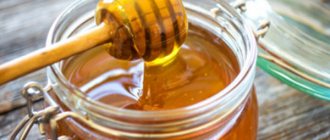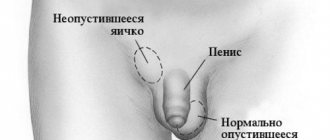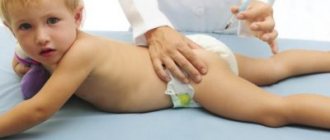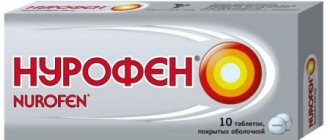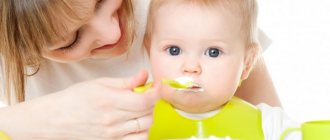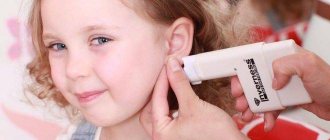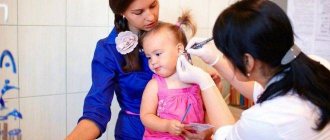09.29.2016 Nadezhda Plotnikova 3 comments
Earrings on the tiny earlobes of small children look especially touching and cute. However, the question of at what age it is possible and when is the best time to pierce a girl’s ears is not only an aesthetic, but also a medical problem.
Some mothers are sure that the ideal time for this procedure is 6-8 months, others wait up to a year, and others go to specialists no earlier than five years.
And yet, when is it better to pierce a child’s ears? It is important to find out the recommendations of pediatricians and dermatologists, as well as choose the right salon to carry out the piercing as safely as possible and without consequences.
Content
- At what age can you get your ears pierced?
- Is it harmful for a girl to pierce her ears too early?
- How does the time of year affect a child's ear piercing?
- How to prepare your ears for piercing
- How to speed up healing after ear piercing
- Where is the best place to get your ears pierced?
- How to pierce ears
- When should you not pierce your child's ears?
Earrings are one of the first jewelry that girls wear. Parents who want to pierce their little ones' ears are wondering where and when is the best time to do it, what is the best piercing method, and how to prepare? There is no consensus on when it is best to pierce a girl’s ears. Some do this as early as six months, while others last up to 5-6 years or more.
Some important points
So, I know a few things for sure about ear piercing:
it doesn't hurt and it's fast; this needs to be done by professionals; First, it is better to wear earrings made of medical steel - this way the wounds will heal faster, and then wear gold and other metals.
I had no idea how to choose a salon and cosmetologist.
The first thing that came to mind was: a medical cosmetology center , or beauty salons, of which there are many - they all provide the services I need, but I have not heard reviews about any of them. I decided to use the services of one lady, who was strongly recommended to me by almost all the mothers I knew, and separately. They praised the same cosmetologist, his professionalism and ability to work with children, in short they sang odes. There was also the opportunity to order the services of this cosmetologist at home - in a home environment the child is calmer and not so scared.
So I decided to use the service of calling a cosmetologist at home. We tried several times to arrange a meeting at our home, but it didn’t work out. And yesterday it didn’t work out again, but we weren’t too upset, and we went to her salon ourselves. This turned out to be the right decision.
At what age can you get your ears pierced?
Parents and especially grandmothers are often against early piercing, but what do experts say? Psychologists advise having your ears pierced before the age of one, and sometimes even indicate the exact age - 8-9 months. The reason for the puncture at such an early age is explained by the increased pain threshold, and the child immediately forgets the trauma he suffered.
Pediatricians have their own opinion on this matter. They advise that a child's ears should be pierced after three years of age due to the risk of infection. At three years of age, the immune system is stronger, so the likelihood of catching an infection is less, and it is easier to cure it. Pediatricians also assure that the child will be able to explain the need for the procedure.
Experts also recommend piercing the ears of a child under 10-11 years old, so that after the wounds heal, keloid scars do not form. A cosmetic defect upsets the parents and the girl herself.
Often, parents wondering whether it is possible to pierce their young children’s ears decide to postpone this procedure until the girl herself expresses a desire to wear earrings. This happens both at 3 years old and at 10 years old - always in different ways. It turns out that all people have different attitudes towards piercing a child’s ears, but there are several pros and cons, which we will now consider.
Is it possible to have a little girl's ears pierced?
Opinions are divided on this issue. Psychologists recommend doing this for up to a year. Their argument is simple - a ten-month-old child is not yet subject to negative perceptions, while at three years old he can experience real stress, which can lead to a refusal to decorate.
Mothers want to see their daughters as little princesses, hoping for less infection of wounds from punctures in infancy.
However, experts cite a number of serious arguments against early piercing:
- Duration of healing of the earlobes and duration of discomfort.
- Restrictions on the use of medications for infants.
- Pain and bleeding of wounds due to frequent clinging of earrings to clothes or the girl’s involuntary attempts to tear off an interfering object.
- Risk of swallowing small shiny jewelry.
- Possibility of developing allergies.
- Numerous nerve endings concentrated in the earlobe can be affected. This can even lead to a delay in the development of the child’s psyche.
Should you get your ears pierced early or not?
It is impossible to say unequivocally when it is possible to pierce a child’s ears, so we will consider the positive and negative aspects of this procedure at an early age to make it easier for you to decide.
Arguments against"
- Regardless of sterile conditions, there is a risk of infection. There are also points on the earlobe that influence the baby’s thought processes and development.
- An allergic reaction to nickel in the alloy is possible.
- Some consider earrings inappropriate for girls aged 1-2 years, but this is a very controversial point.
- A child may get caught on something in the decoration during active play, damaging his ear.
- A little girl can lose an earring and even swallow it.
Arguments for"
- Earrings on a girl are beautiful, and on the playground no one will confuse your baby with a boy.
- The pain threshold in children is higher. Of course, the child will cry or scream, but will soon calm down and forget about everything.
- After 11 years of age, the likelihood of scarring on the earlobes increases.
How does the procedure work?
Now let's get down to business. Some mothers will be interested in how the procedure for pinning the ears of a small child goes:
First, we were given the choice of future earrings - there were so many of them, we couldn’t decide on the choice. We decided - we took it with the “pearl”. The cosmetologist assessed the child’s earlobe, measured something with a ruler and placed dots at the site of the future puncture. I disinfected my ears. The child sits down next to the mother, the mother holds her hands and head - at this time one and then the other ear is pierced. The earrings are put on immediately - at the moment of puncture, immediately after that the latch is put on. The puncture sites are lubricated with some kind of gel.
A silent gun was used during the ear piercing procedure - this is really important. A click can frighten a child, he can jerk sharply, etc. - there is no need for extra noise here. At the moment of the puncture, the beautician spoke to the girl and said that a mosquito had flown in and bit her in the ear. ?
My daughter was very positive about this procedure, so she did not cry, did not twitch or scream. She really wanted earrings! I advise you not to set your child up for the fact that it will hurt - say that it will sting a little and that’s all, but there will be earrings in the ears.
Best time of year to get your ears pierced
Parents planning to pierce their child's ears often do not think about when and at what time of year to carry out the procedure. Experts have recommendations on this matter that are worth listening to:
- In the winter season, doctors do not recommend piercing their ears, as they can get cold, and children also wear knitted hats and turtlenecks, which can get caught on the earring and injure the earlobe.
- The best period for this procedure is the beginning of spring and the end of autumn. The reason is similar to the above.
- In the heat of summer, due to the high temperature and dry air, the risk of infection in the wound increases, and healing is also greatly delayed.
- The best time is September or May. During these months it is not too hot, like in summer, and knitted hats and sweaters are no longer worn. The chances of quick and problem-free healing of the earlobes are highest.
Thus, you need to take into account not only at what age the puncture should be done, but also remember the time of year.
How to properly pierce your ears
The author of the article is Svetlana Vladimirovna Petina, chief physician of Children’s Kuntsevo. The article was published in the magazine “Rody.ru” No. 5-2016
Almost all women love to decorate themselves: hairstyle, cosmetics, hairpins, earrings, beads - everything goes into use. Therefore, when a girl appears in the family, many mothers decide to pierce her ears. What is the best way to do this, where to go and how to properly care for pierced ears?
best age
Let’s say right away that there is simply no best age at which to pierce a child’s ears. For example, some experts believe that it is easiest to do this before one and a half years, when the child does not experience a feeling of fear and quickly forgets about the pain. That’s how it is: the little ones instantly forget about the procedure and how their ears healed after the piercing. But on the other hand, a little girl is not always able to control her movements and can catch an earring and injure her earlobe. In addition, it is more difficult for young children to treat their ears after a piercing: they simply do not understand why they have to endure sometimes unpleasant procedures. Therefore, there is another opinion: ears should be pierced when the child himself asks to do it.
Then the girl will already understand why they do this to her, and it will be easier to care for her ears. Well, be that as it may, only the family decides at what age to pierce a child’s ears.
where to get your ears pierced
Now you can get your ears pierced in almost every medical center or beauty salon. But it’s still better to do this in a place where there is a license for medical activities, and a children’s clinic would generally be an ideal option.
Firstly, in a clinic a specialist (doctor or nurse) will most likely be more qualified than in a simple beauty salon; secondly, in a children's institution, employees have experience in how to communicate with a small child (after all, a girl may get scared and cry during the procedure). Well, and most importantly, in medical institutions they still take hygiene and compliance with sanitary standards more seriously, and there is a larger selection of different devices for punctures. In addition, a specialist with a medical education will always tell you exactly how to properly care for the puncture site, what should be used to treat it, and what not to do.
how to pierce
The most modern way to pierce ears is a special “gun”. The ear is pierced with disposable needle earrings
(as if shot through), and the earring remains exactly at the puncture site. Such earrings (in the form of “studs”) become the first for a girl. The manipulation lasts a matter of minutes and is practically painless. But sometimes the child gets scared by the characteristic sound that the “gun” makes when piercing, cries and even refuses to pierce the second ear. Therefore, now an even more advanced model of the “pistol” has appeared, which operates on a different principle. During a puncture, the tissues of the earlobe seem to move apart, so the manipulation itself becomes even less painful and almost silent. Well, the old method of piercing the ears with a (sterile) needle is no longer used almost anywhere: it is both inconvenient and painful, and you may not get into the precisely chosen place.
choice of earrings
While the child is small, earrings “for every day” should be as light as possible, without additional decorations or pendants. Otherwise, heavy earrings will pull down your earlobe. In addition, long dangly earrings make it easier to snag clothes or simply touch them while playing, which means somehow damaging the earlobe. So the best option for everyday jewelry is stud earrings, but for a holiday you can wear something more intricate.
One more thing to consider is the material from which the earrings are made. Usually, the very first children's earrings are made of medical alloy (it is less allergenic).
But silver is not suitable for the first puncture - it actively oxidizes upon contact with human blood and lymph, as well as upon contact with some antiseptics (the jewelry itself and the skin around it turn black).
Well, what to wear in the future when the ears heal -
gold, silver, platinum or just jewelry - you can’t guess, the material will have to be chosen by trial and error (the reaction can be to any metal).
when you don't need to pierce your ears
There are situations in which it is not worthwhile to pierce a child’s ears: for example, if a girl has a predisposition to keloids or the wounds do not heal well; if she has recently suffered from an infectious disease or feels unwell; if there is an allergy to metals, and simply if the child does not want or is afraid to do it yet. It is also better
not to pierce your ears in extreme heat: the piercing site may take longer to heal.
There are children who do not like to wear a hat in winter and constantly strive to take it off, then it is better to postpone ear piercing until the warm season: after all, often taking off the hat, the baby can touch the piercing site. after a puncture
The ears are pierced, the earrings are inserted, now we just have to wait for the holes to heal. What to do to make this happen quickly and without complications:
- – in the first 2–3 days, it is better not to wet the puncture site with water;
- – try not to touch the ears with clothes, and do not let the child touch them with his hands;
- – monitor the condition of your ears and regularly treat them with antiseptics. Usually, for 2-3 weeks, the puncture site and the earrings themselves are treated with antiseptics 3-4 times a day, without turning the jewelry. There is another way to care for your ears: seal the puncture site with medical glue, thus securing the earrings, and do not touch or twist them until the glue gradually comes off on its own. After this, the earlobes are wiped daily with disinfectant compounds until complete healing. The ear piercer will determine which method of care to choose. The earrings are not removed until the holes are completely healed.
If you get your ears pierced by a good specialist and then take proper care of them, they will heal quickly and without complications. And the result will undoubtedly bring pleasure to both the parents and the girl herself.
Petina Svetlana Vladimirovna Pediatrician, Hematologist Mother and Child Clinic Kuntsevo
- Find out more about the doctor
- Make an appointment
Other articles by the author
- FROM THE FIRST SPOON
By six months, the baby’s physiological needs increase - now additional substances, vitamins and microelements are needed for his growth and development. The time has come to add “adult food” to breast milk or formula - to start complementary feeding.
- feed in any position
Do you want to breastfeed your baby? Great! There are no difficulties here, you just need to want it and put the baby to the breast correctly. And both you and the baby should be comfortable during feeding - this way the process will be much more effective.
The article was published in the magazine “Rody.ru” No. 3-2018
- MILKY WAY
The benefits of breastfeeding are difficult to overestimate, but women are already wary of the difficulties associated with this process. Chief physician of children's Kuntsevo, pediatrician Svetlana Vladimirovna Petina
comments on the most popular myths dedicated to this important stage in the life of mother and baby.
- SLEEP SCIENCE
A baby's sleep from birth to one year is perhaps the main subject of discussion among young parents. We have collected 10 useful tips that will help improve sleep not only for your child, but for the whole family.
- New Year with baby
Author of the article –
Petina Svetlana Vladimirovna, chief physician of Children's Kuntsevo. The article was published in the magazine “Rody.ru” No. 1-2018
Everyone loves the New Year, and now that there is a baby in the family, we are especially looking forward to this holiday, because now we can celebrate it in a new way. What can be done to make the New Year's holiday enjoyable and memorable, both for mom and dad, and for the child?
- Hot tips, walking in the heat
Svetlana Vladimirovna Petina, a doctor of the highest category, hematologist, pediatrician at the Mother and Child clinic in Kuntsevo, answers the questions. Published in the magazine "Rody.ru"
Everyone loves to go for walks in the summer, especially parents of children. What could be better: the sun is shining, you can get ready to go outside in five minutes, putting a minimum of clothes on your child, and the choice of places for walks is huge: if you want, go to the playground or to the forest, or you can even go somewhere in the city, walk along beautiful streets or sit in a cafe, go to some interesting place. But if it’s not just warm outside, but the heat has begun, then you need to walk a little differently. We'll tell you what to consider when going outside with your child in hot weather.
- Dry air: how does it bother children? If you don’t want to get sick, humidify the air!
Svetlana Vladimirovna Petina, pediatrician, Chief Physician of Children's Kuntsevo, answers the questions. The article was published in the magazine “Rody.ru” No. 2-2017.
Is your child often sick, does he have allergies, or for some reason does he have a stuffy nose all the time? The doctor advised you to strengthen your immune system and you ran to the pharmacy for a new miracle drug? Or maybe the baby doesn’t sleep well, is capricious, and you think that all this is due to teething or magnetic storms? Start with the simplest thing: check the microclimate of your home, in particular, air humidity. It turns out that dry air is a common cause of illness and poor health in young children.
- Go for a walk!
Svetlana Vladimirovna Petina, pediatrician, Chief Physician of Children's Kuntsevo, answers the questions. The article was published in the magazine “Rody.ru” No. 1-2017.
You need to go for a walk with the children
-
everyone knows this.
In the summer this is easy to do -
pack up and go, but winter walks raise many questions.
How to go for a walk if there is frost or a snowstorm outside? How much time? In what weather and what to wear? The child is still so small and defenseless -
won’t he get sick in the cold air? And then is it necessary to go for a walk in winter at all? Let's talk about winter walks. - First aid kit for newborns
The author of the article is Svetlana Vladimirovna Petina, a doctor of the highest category, hematologist, pediatrician at the Mother and Child Clinic Kuntsevo. The article was published in the magazine “Rody.ru” No. 12-2016.
The first month after the birth of a child is a pleasant time, but also a troublesome one: the child requires not only feeding and attention, but also daily care. Every day, parents will need to bathe the baby, clean his nose and ears, cut his nails, treat skin folds and the umbilical wound. To make it easier for the mother to cope with all this, it is necessary to have a separate first aid kit for the baby, which will contain everything necessary for hygiene and first aid for the child. What should be in a children's first aid kit?
- Infant swimming
The author of the article is Svetlana Vladimirovna Petina, hematologist, pediatrician. The article was published in the magazine “Rody.ru” No. 8-2016.
Today, there are many early methods for the development and health of babies, and one of the popular trends is infant swimming. Almost every city children's clinic has an office where there are large baths or even a swimming pool for children under one year old, not to mention all kinds of sports centers and fitness clubs: there may be an even greater choice of activities. But not all parents understand exactly what infant swimming is and why it is needed, much less how to carry it out correctly. In addition, infant swimming has both supporters and opponents. Let's tell you about everything in more detail.
Preparing for ear piercing
Getting a child's ears pierced is a very important responsibility, even though the procedure is simple. It’s worth preparing for it and finding a good place with an experienced master who will do everything carefully, correctly and painlessly. Smart mothers always start with medical advice. You should take the time to visit the following doctors and consult with them:
- Pediatrician. Conduct a general examination and recommend diagnostic procedures such as blood tests and checking blood sugar concentrations.
- Ophthalmologist. The earlobes, as strange as it may sound, are connected to the visual organs. The connection is due to nerve fibers, so if your vision is impaired, it is better to postpone ear piercing.
- Allergist. All alloys contain nickel compounds that provoke allergic reactions in case of hypersensitivity of the child's body.
Parents should be aware that the piercing procedure is stressful for the child, so he needs to be prepared. Remember and consider the following recommendations:
- Only completely healthy children can have their ears pierced. Even if the girl has a cold or is sick with something else, postpone the procedure for a more appropriate time.
- Prepare your child and explain where you are going. There is no need to hide anything so that the baby can tune in.
- If the girl is old enough (over three years old), try to interest her by involving her in the process of choosing earrings.
- Prepare some kind of gift for courage that the child will receive after the procedure.
- It is necessary to establish contact between the master and the child.
Contraindications
Of course, you should also know the contraindications for punctures:
- ear diseases, including chronic ones;
- development of serious skin diseases, diabetes, etc.;
- acute colds and flu (at least two weeks after recovery);
- problems with blood clotting and tissue healing;
- blood diseases;
- immunodeficiency;
- high sensitivity to pain;
- allergic reactions;
- general malaise of the baby;
- threat of keloid scars.
Rules of care for healing
It is necessary not only to pierce correctly, but also to properly care for the lobes afterwards. Complete healing usually lasts from a month to three, and the following is required from parents:
- Explain to the girl that jewelry should not be touched, especially if your hands are dirty.
- You cannot change earrings until the wounds have healed.
- During healing, it is better to put your hair in a ponytail or make a braid.
- Twice a day you need to treat your earlobes with antiseptics. Experts usually recommend hydrogen peroxide or chlorhexidine.
- Five days after piercing, start turning the earrings around the axis.
- After piercing your ears, it is not advisable to get them wet for the first 4-5 days.
If you find yellowish discharge from the wounds, treat them with a light solution of potassium permanganate. The pus should disappear in a couple of days, but if this does not happen, go to the doctor - the suppuration cannot be left, and it is unlikely to go away on its own.
What to do if your ear starts to fester
An unpleasant consequence of the piercing is the wound in the baby’s ear becoming suppurated. Poorly processed piercing devices, improper care after the procedure, and replacement of earrings can provoke an inflammatory process and infection. A scar may remain on the ear, and the girl will no longer be able to wear earrings.
To eliminate suppuration and exclude other complications, treatment should be started immediately:
- Consult a doctor . Especially with prolonged suppuration, detection of redness in the neck area, compaction in the lobe, in the future it may turn black due to tissue death.
- Apply medication to the wound yourself. Use " Miramistin " to spray the wound 2-3 times a day, " Solcoseryl ", " Levomekol ", lubricate the inflamed areas with syntomycin ointment. You can wash out the suppuration with hydrogen peroxide.
- Urgently go to the surgeon if the ear turns black, begins to swell, or the child has a fever. The doctor will administer anesthesia and examine the baby. Surgical intervention may be required to eliminate the source of inflammation and clean the wound from pus.
- Don't ignore folk remedies. Grandmother's advice helps treat inflammation without medication:
- aloe juice draws out pus, heals the wound, relieves pain;
Cut a leaf of the plant in half, attach it to the ear, and replace it with a new one after two hours. Use the recipe several days in a row.
- baths with sea salt disinfect the wound.
Self-piercing of children's ears at home often leads to complications. This is absolutely not allowed !
Inflammatory processes on the lobe and inside the auricle lead to serious consequences. These are paralysis of the facial nerves, keloids, tissue ruptures, hearing and vision disabilities. It is unknown how many troubles await in this case and how many complications you will encounter.
Make the right choice by entrusting your child to professionals. This way you will protect your little princess from complications, and she will be happy with her earrings in her little ears.
Where to get your ears pierced?
The next stage is choosing a good salon or medical facility where the procedure will be performed. Every parent should understand that the procedure should not be done at the nearest hairdresser. Don’t be too lazy to turn to professionals at a clinic with a good reputation - in this case, your child will not get an infection.
An experienced specialist knows the safest puncture points and carries out the procedure completely painlessly and without complications. Parents should make sure that all instruments and earrings are sterile.
Good clinics offer jewelry made from high-quality medical alloys. They are loaded into a special gun and used to pierce the earlobe, and when the wounds heal, the parents remove the earrings and insert any others.
Choosing earrings for a child
| Material | Initially, it is better to put earrings made of special medical steel, titanium compounds or bioflex into children’s ears. All these materials are hypoallergenic. | Once the wounds have healed, you can purchase silver or gold earrings. |
| You should not wear them at the time of piercing, since gold contains allergic impurities, and silver oxidizes. | ||
| Form | There are many varieties of earrings for babies. But for the first time it is better to stick to standard small carnations. But the shape of their “head” can be varied: hearts, triangles, balls, etc. | |
| Surface Features | Earrings must be absolutely smooth, the surface without various protrusions, burrs and sharp parts that could scratch the child's skin. | |
| Presence of stones | Small, neat stones (not diamonds, of course, for the safety of the baby) are quite acceptable, especially when it comes to older children. Earrings without stones are also suitable for infants. | |
| Lock type | The ideal option is the same nails with a convenient clasp that a child cannot open on his own or damage. | After healing, you can put on earrings with an English lock that does not squeeze the earlobe. It is also difficult to open with children's hands. |
| Weight | The earrings should be light, otherwise the baby will feel heavy and uncomfortable on her own ears. Naturally, we are not talking about comfortable wearing. |
Ear piercing methods
Parents are always interested in ways to pierce girls' ears. There are several options, among which you can choose the appropriate one, but in the first place is perfect sterility!
Needle
The most primitive method of piercing involves the use of a special disposable catheter needle. The procedure has the main advantage of being able to choose a needle to fit the size of your earlobes. You can also put any earrings into pierced ears, not just standard studs. Puncture with a needle is done simply:
- the ears are thoroughly disinfected on all sides;
- the puncture site is outlined;
- punctures are made;
- earrings are inserted;
- A healing cream is applied to the earlobes.
Often, needles cause fear in children, and the procedure is slow and painful, so it is better to use this method at an older age - from 8-10 years. And despite the fact that many are ready to pierce their ears on their own, we still recommend entrusting this process to a specialist so as not to damage the earlobe during the piercing. For those who are confident in themselves, we suggest watching a video on how to pierce your ears yourself.
Gun
Before piercing her ears with a pistol, the girl’s earlobes are disinfected and the puncture points are marked. The previously selected stud earrings are charged into the device. The lobe is inserted into a special slot at the end of the gun, after which it is fired. The puncture is made not with a needle, but with a charged earring. The procedure takes a minimum of time, and small children are usually more afraid of the click itself rather than the pain. After the procedure, the ears are treated with a healing cream.
The technique has one drawback compared to the needle. The hole is not perfectly smooth, but a lacerated wound appears, which is why a keloid scar remains. Despite this, the gun is better suited for piercing the ears of very young girls.
System 75 tool
The standard gun described above is a reusable instrument that accepts sterile earrings. The tissue is torn and a loud click is heard. The System 75 medical instrument is disposable and therefore has absolute sterility.
Externally, the device looks like a stapler with a disposable cartridge. The specialist does not even touch the jewelry, and the special sharpening of the tips of the earrings prevents tissue tearing and the formation of a torn wound on the earlobe. Thanks to this, it heals quickly, and the likelihood of complications and other negative consequences is reduced to zero. The piercing procedure is also painless and almost silent, so the child tolerates it relatively calmly.
How to choose the right first earrings
The criteria for choosing the first jewelry for a girl are no different from the criteria for choosing any children's item:
- Convenience. Earrings should be light so as not to weigh down the earlobe, comfortable to wear and remove, so that the girl can handle them herself if necessary.
- Hygiene. The decoration must be made of special materials, for example, Teflon or medical gold. Such earrings do not affect the healing of punctures in any way, which means that this process will pass quite quickly.
- Safety. Choose small jewelry, without parts that clothes or hair can get caught on. You should also avoid long earrings or large rings, large stones and other excesses. The earring should not interfere with the fidget.
- Quality. It is better to buy such a device in a specialized store that has certificates for the product. It is important to check the clasp; it must be strong so that the earrings do not fall out on their own.
When a suitable first decoration has been selected, it is necessary to decide where exactly the procedure itself will take place.
Contraindications for ear piercing in children
Finally, let’s find out when it’s better not to pierce your ears. The medical procedure is associated with some risks, although minimal, so you need to remember about contraindications, including:
- disturbances in the composition of the blood (poor clotting);
- diabetes;
- weakened immunity;
- ongoing diseases;
- tendency to allergies;
- low pain threshold.
Doctors also advise against piercing children’s ears during the period of routine vaccination.
In the cabin
Also read:
The daughter behaved very confidently in the presence of beautiful aunts, she was interested in everything. Her aunts told her that getting her ears pierced doesn’t hurt at all, and then she can wear beautiful earrings.
And here we must pay tribute to the cosmetologist - she really spoke to her daughter in such a way that she did not understand when they pierced her first ear, when they pierced the second - she squeaked a little and immediately ran to the mirror to spin around and show off the earrings in her ears.
She was very encouraged by the compliments from the women present, I think at home she would have been less delighted - after all, there are no beautiful women there with compliments?

